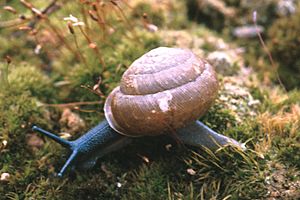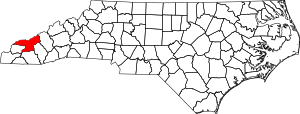Noonday globe facts for kids
Quick facts for kids Patera clarki nantahala |
|
|---|---|
 |
|
| Conservation status | |
| Scientific classification |
|
| Kingdom: | Animalia |
| Phylum: | Mollusca |
| Class: | Gastropoda |
| Subclass: | Heterobranchia |
| Clade: | Euthyneura |
| Order: | Panpulmonata |
| Clade: | Eupulmonata |
| Clade: | Stylommatophora |
| Family: | Polygyridae |
| Genus: | Patera |
| Species: |
P. clarki
|
| Subspecies: |
P. c. nantahala
|
| Trinomial name | |
| Patera clarki nantahala (Clench & Banks, 1932)
|
|
| Synonyms | |
|
Polygyra (Triodopsis) nantahala |
|
The noonday globe snail (scientific name: Patera clarki nantahala) is a special type of land snail. It belongs to a group of snails called Patera clarki. This snail is only found in one specific place: North Carolina in the United States. It's part of the Polygyridae family, which includes many land snails.
Contents
What's in a Name? The Noonday Globe
The name "nantahala" comes from the Cherokee language. It means "noonday." This snail got its name because it lives in a very deep valley called a gorge. In this gorge, the sun's rays don't reach the ground until the middle of the day, around noon!
Shell and Body
The shell of the noonday globe snail is a medium size. It is about 3/4 inch (18 mm) wide and 1/2 inch (11 mm) high. The shell has a round, globe-like shape.
Its outer surface is shiny and has a reddish color. The shells usually have about five and a half spirals, called whorls. The shell's surface has rough lines on it.
The area around the shell's opening (aperture) is white. Inside the opening, there is a long, curved "tooth." The snail's body itself is black.
Where the Noonday Globe Snail Lives
The noonday globe snail is found only in North Carolina. Specifically, it lives in the Nantahala Gorge in Swain County. This area is part of the Appalachian Mountains.
These snails live along about two miles of tall cliffs. These cliffs are on the eastern side of the gorge. This snail has probably never lived in many places. Its natural home, which has steep, wet slopes and special rocks, is rare in western North Carolina.
The snail's habitat changed when a railroad and a major road (U.S. Route 19) were built. These projects changed the forest near the river. More sunlight could reach the gorge, making the lower slopes drier. This allowed new plants like kudzu and Japanese honeysuckle to grow.
To protect this special snail, the United States Fish and Wildlife Service listed it as a threatened subspecies on July 3, 1978. It is against the law to take a noonday globe snail. Breaking this law can lead to a large fine and even jail time.
Snail Ecology
Since this snail is very rare and lives in only one small area, scientists don't know much about its daily life.
Habitat and Environment
This land snail lives in damp oak-hickory forests. The cliffs in the Nantahala Gorge are very wet. Many small streams and waterfalls flow through them.
The forest here is old, with many large trees and different kinds of plants. The forest floor has a thick layer of rich humus (decaying plant matter). There are also many exposed limestone rocks. Snails need Calcium carbonate to build their shells. This mineral is usually hard to find in other cliffs nearby.
The rich, moist, and calcium-rich soils, along with the old forest, help many different snails live here. The noonday globe snail is found living with 29 other snail species. This snail seems to be most active when the weather is wet. During these times, it often moves onto plants instead of staying under leaves on the forest floor.
Feeding Habits
Scientists are not sure what P. clarki eats. However, other snails in the same group, Patera, eat fungi. They especially like the tiny, hair-like parts of fungi that grow underground, called mycelia.
Life Cycle
Scientists do not yet know how this snail reproduces or what its full life cycle is like.
Relationships with Other Animals
Snails are often eaten by other animals. A meat-eating land snail called Haplotrema concavum has been seen eating a noonday globe snail. Also, shells of a related snail, Patera clarki clarki, have been found with bite marks in the dens of small rodents. This shows that rodents might also eat these snails.




